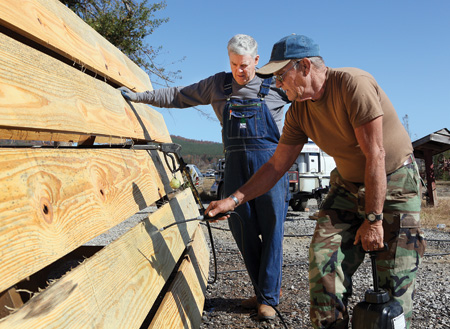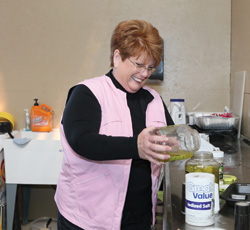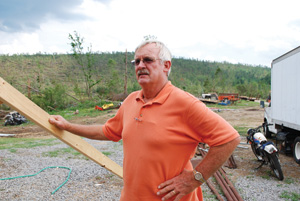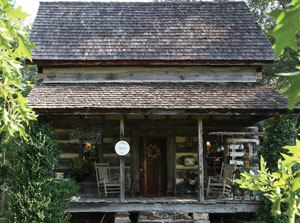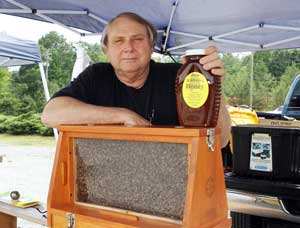Master ‘tinkerer’ turning heads around the world
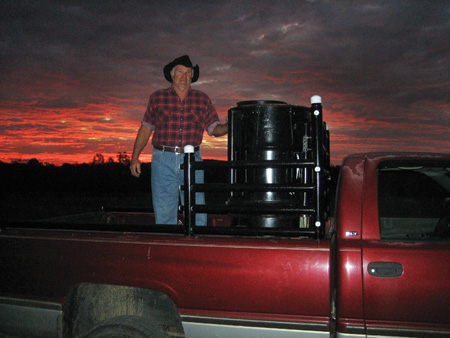 Story by Mike Bolton
Story by Mike Bolton
Photos by Jerry Martin
For those who have never met St. Clair County’s Wayne Keith, the first impression is never what was expected.
To the Mother Earth News crowd to whom he is becoming a cult hero of sorts, he doesn’t have the long hair and tie-dyed T-shirt they envisioned. To the college professors who are flying him across the U.S. to speak to distinguished panels so his vast knowledge may be harvested, he’s neither the polished engineer with a pocket protector full of slide rules or the quirky inventor that they might have imagined.
Wayne Keith is just a 63-year-old farmer in overalls who likes to tinker. “He’s just a regular guy” is the resounding response from those who meet him for the first time.
On this morning, Keith arrives at the Jack’s in Springville, and his old, wood-burning Dodge truck that is causing such a stir across the U.S. and in foreign countries doesn’t even get a second glance. An old pickup truck with three big drums in the back is as common of a sight in Alabama as Hoverounds are in south Florida.
Inside, he joins the gathering of old men who assemble daily at what they jokingly refer to as the table of knowledge. There, the old men sip coffee and feign genius as they attempt to solve the world’s problems. Keith’s presence in the group is a paradox. To the old men, he’s just Wayne, the local farmer that they have known all of their lives. He is unique, however, in that he’s actually a genius solving the world’s problems.
While the old men tell their stories, Keith doesn’t bother to explain that he has just returned from the Go-Green Festival in Missouri, where his wood-burning truck was held in great awe by patrons. Nor does he explain that he was the keynote speaker at the Environmental Protection Agency’s national convention in Atlanta. There, the good old boy armed with nothing more than a Springville High diploma was surrounded by some of the most-educated environmental scholars in the world.
“When I sit on these panels, I’m the only one that doesn’t have Ph.D at the end of my name,” he says from the log cabin he built in the woods near the St. Clair Correctional Facility in St. Clair Springs. “It’s always a little humbling.”
Before Keith got the world’s scholars attention with a truck that burns firewood instead of gas and travels 5,200 miles on a cord of firewood, he says he was just another bored high school student and an uninspired worker who was unhappy with his job for four decades.
“In high school, all I cared about was hunting, fishing and building stuff,” he said. “Going to college was never considered.
“I worked in the engineering department of a trailer manufacturing plant, and I spent five years building small trailers on my own. I was a Springville policeman for years with the K-9 unit, and then I went to St. Clair Prison as the dog trainer there. The whole time I farmed.”
The entire time he was working in a controlled environment, he yearned for something else, he says. An avid reader, he once read about vehicles from several countries being forced to run off of burning wood because gas was in short supply during World War II. That piqued his interest.
“When we had the oil crisis in the United States in 1973, and the price of gas shot up, I began reading more and more on the process of gasification (burning bio-mass to convert into a flammable vapor),” he said. “I learned everything I could find out about it.
“But in 1974, the oil embargo was lifted, and gas prices went back down. I just kind of forgot about it.”
Keith became somewhat of a noted tinkerer and inventor in the years that followed. He built a sawmill from junk steel he gathered from around his farm, and he cut wood for locals wanting to build their own homes. He estimates he has cut lumber for about 60 local homes.
He eventually cut wood from his own farm and built his own log cabin on the property. The beautiful home boasts oak floors and beams as well as numerous other woods throughout.
“No other human hands except those of me and my wife touched the cabin while we were building it,” he said. “We never bought anything to build the house except nails.
“The sawmill has operated 12 years, and there has never been a breakdown.”
Building your own home isn’t that big of a deal for many in rural Alabama, but Keith’s next invention got local tongues wagging. He took scrap metal from his farm and built what he called a “Flying Jenny.” The carnival-like ride had kids across the county clamoring for a ride, especially when they learned it would toss them in a nearby creek.
But it was Keith’s next project and the increasing cost of electricity that made local adults sit up and take notice. The 63 year-old built two windmills on his farm near his house, and the wind-driven fans supplied more than half of the electricity needs for his home. Soon after, others wanted plans, so they could build their own on their farms.
“The windmills have a generator that direct current to a battery bank,” he explained. “The battery bank has an inverter that converts the battery power into power that can run your home.”
Those windmills were destroyed in a storm earlier this year, but he plans to build them back.
Keith insists he is neither an environmental nut nor should he be a hero to the “Green” crowd, but almost reluctantly he admits he more and more is being seen as such. He insists he’s just a tinkerer who is looking for a cheaper way of getting through everyday life.
“I’m not a tree hugger,” he says with a laugh, “but if something I build allows me to do things more cheaply and it is more environmentally friendly, that’s fine, too.”
Gas prices fuel Keith’s innovation again
Rising gas prices in recent years once again piqued Keith’s interest in the wood-burning powered vehicles of World War II.
“I drew a line in the sand and decided that in 2004 if gas hit $1.50 a gallon, I was going to do something,” he said. “When gas reached that point, I started studying.”
The worldwide availability of cheap gasoline and the inefficiency of wood-burning vehicles caused the gasification process to pretty much be ignored following World War II. Keith by no means invented the process, but scholars say what he is done has perfected it to the point that it has now become viable.
What gasification does is take a bio-mass, such as dried wood, and burn it in a low-oxygen container. That converts the burning bio-mass into a combination of hydrogen, carbon monoxide and methane, the vapors of which are flammable. The vapors are piped from the three containers (one of which is a fuel filter made from hay) in the back of the truck to the engine where it burns like gasoline.
Auburn University and Texas A&M have run extensive tests on Keith’s trucks and have come up with startling conclusions. Since the vehicle completely burns the wood and emits no smoke, it results in 70 percent lower emissions than the total electric vehicles on the market today. The only real emissions are the ashes which are called bio-char, and they make excellent fertilizers for gardens. There is also water condensation that must be drained.
Tests show the process is 37 percent more fuel efficient than gasoline.
David L. Bransby, professor of bioenergy and bioproducts at Auburn University, says Keith is not some country bumpkin inventor. He says Keith’s near perfection of the gasification process has created interest across the U.S. and world.
“He’s an extremely smart individual,” Bransby said.
“I know of no well-qualified engineers that have been able to accomplish what he’s done. And he’s done it without any college education. His understanding of the process is exceptional.”
Keith’s plans are to work out a few more kinks in the process and then apply for patents. At that point, he plans to sell the process to a company that will convert trucks from gas to wood-burning.
Land-grant universities from across the country are interested in the process for an entirely different application. Bransby says he doesn’t see the process as being viable for most U.S. drivers but sees it as a low-cost source of energy for farms. An internal combustion engine coupled with a generator could produce electricity to power chicken houses and cattle operations and the waste-heat generated from the engine’s exhaust could supply heating needs.
Meanwhile, Keith is traveling the country speaking to universities about the process. He’s spoken in Michigan three times and in Kentucky, West Virginia, Florida and other states. He even drove one of his trucks to the Bonneville Salt Flats, where he set a world speed record for wood-burning vehicles.
“Some of these trips, as the one to Bonneville, are up to 2,000 miles round-trip,” Keith said. “You may literally see 1 million vehicles on the road on a trip like that.
“It’s pretty neat to think that you are the only one running off of wood.”





















